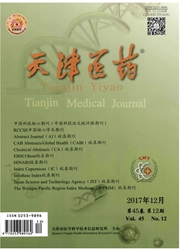

 中文摘要:
中文摘要:
目的探讨缺氧是否能促进不同分化程度结直肠癌细胞上皮间质转化(EMT),并分析缺氧对结直肠癌细胞侵袭、迁移的影响。方法分别选取HCTll6(低度分化)和HT-29(高度分化)结直肠腺癌细胞。观察0、10、25、50、100及150mg/L氯化钴(CoCl2)诱导2种细胞48h后的形态变化。分析0、10、25、50及100mg/LCoCl2处理48h后缺氧诱导因子(HIF)-1α蛋白表达变化,筛选出CoCl2诱导细胞缺氧的最适合浓度。MTT实验检测不同时间点(0、24、48、72及96h)CoCl2诱导2种结直肠癌细胞的增殖情况,筛选出CoCl2诱导缺氧的最佳时间。最佳浓度和时间条件下,对HCT116和HT-29细胞分别进行缺氧(缺氧组)和常氧(常氧组)处理,Transwell侵袭和划痕实验检测2组2种细胞的侵袭、迁移情况;Western blot实验和RT—PCR实验检测2组I-IIF—1α、E-cadherin及Vimentin的蛋白及mRNA表达水平。结果50mg/L CoCl2作用48h时2种细胞均出现明显的形态改变。2组HCT116、HT-29细胞的HIF-1α蛋白表达水平随CoCl2浓度增加均呈先增后减趋势,50mg/L为最适宜浓度(P〈0.05)。0~96h时2种细胞不论有无缺氧,细胞增殖能力均呈先增后减趋势(P〈0.05),48h为最佳作用时间。HCT116和HT-29细胞系中缺氧组穿膜细胞数和细胞迁移率均明显高于常氧组(P〈0.05)。HCT116、HT-29细胞系中缺氧组HIF-1α、Vimentin的蛋白和mRNA表达水平均高于常氧组,而E—cadherin的蛋白和mRNA表达水平低于常氧组(均P〈0.05)。结论缺氧能诱导不同分化程度结直肠癌细胞均发生EMT,并能增强2种结直肠癌细胞的侵袭、迁移能力。
 英文摘要:
英文摘要:
Objective To explore whether hypoxia could promote epithelial-mesenchymal transition (EMT) in various differentiated colorectal cancer cells, and analyse the effect of hypoxia on invasion and migration of colorectal cancer cells. Methods HCT116 (poorly differentiated) and HT-29 (highly differentiated) coloreetal adenocareinoma cells were selected respectively. The morphological changes of two cell lines were observed after 0, 10, 25, 50, 100 and 150 mg/L cobalt chloride (COCl2) treatment for 48 h. The expression of hypoxia-inducible factor-1α (HIF-1α) protein was analysed after 0, 10,25,50,100 and 150 mg/L COCl2 treatment for 48 h. An optimal concentration of CoCl2 was then selected. Methyhhiazolyl tetrazolium (MTT) assay was used to detect the proliferation of two kinds of colorectal cancer cells induced by COCl2 at different time points (0, 24, 48, 72 and 96 h), and to select an optimal time. Under the optimal concentration and time conditions, the HCT116 and HT-29 cells were processed by hypoxia (hypoxia group) and normoxia (normoxic group). Transwell invasion assay and Wound healing assay were used to detect cell invasion and migration in two groups. Western blot assay and RT-PCR were used to detect protein and mRNA expression levels of HIF-1α, E-eadherin and Vimentin in two groups. Results Two kinds of cells showed obvious morphological changes after 50 mg/L CoCl2 treatment for 48 h. HIF-1α protein level first increased and then decreased in two groups of cells with the increased concentration of COCl2, and 50 mg/L CoCl2 was the optimal concentration (P 〈 0.05). The cell proliferation showed a tendency to decrease after the increase in both kinds of cells with or without hypoxia for 0-96 h (P〈 0.05), and 48 h was the optimal time. The transmembrane number and cell migration rate were significantly more in hypoxia group than those of normoxic group (P 〈 0.05). The protein and mRNA levels of HIF- 1α and Vimentin were significantly higher in hypoxia gro
 同期刊论文项目
同期刊论文项目
 同项目期刊论文
同项目期刊论文
 期刊信息
期刊信息
